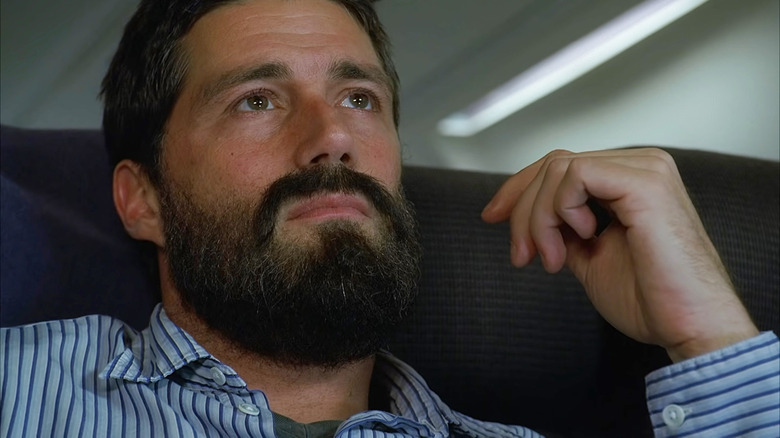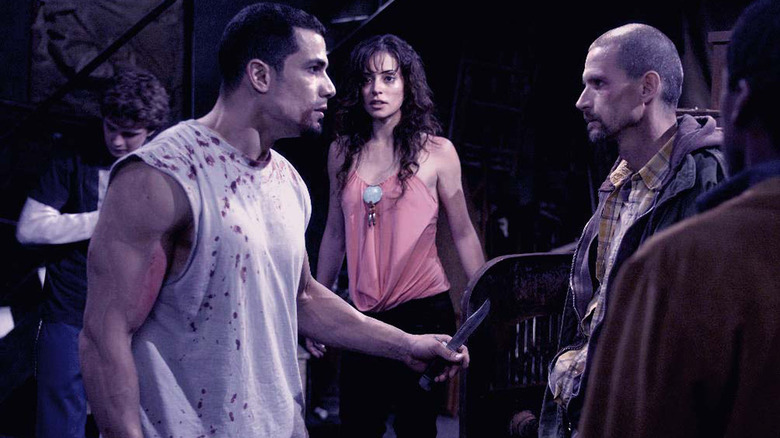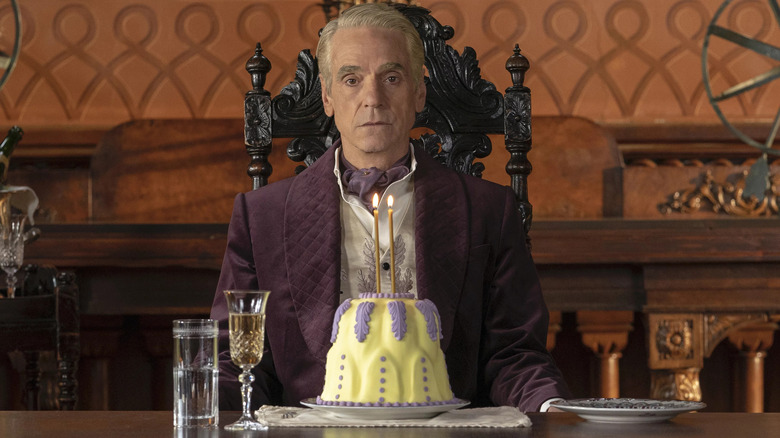Damon Lindelof's Favorite Lost Cliffhanger Was Inspired By A Bloody Horror Sequel
This post contains spoilers for "Lost" season 3 and "Saw II."
With "Lost" streaming on Netflix in time to mark its 20th anniversary, a new generation of viewers have the chance to watch perhaps the greatest episode in TV history: the show's season 3 finale, "Through the Looking Glass." It's a jam-packed two-part installment, although it starts off a little weird with its constant recurring flashbacks around Jack Shephard (Matthew Fox). The show had given us so many Jack-centric episodes by this point that it felt sort of anti-climactic to center the finale on him too. It also seemed strange that Jack apparently had a sad alcoholic phase we'd never been privy to before. Still, after nearly 60 episodes straight of pre-island flashbacks, most viewers were happy to go along with this, especially since the on-island storylines were so compelling.
In the final scene, we see Jack meeting up with Kate, someone he didn't know before the plane crash. And then he's talking about wanting to go back to the island. Surprise! These flashbacks are actually flashforwards; after three seasons of the show's characters trying to escape the island, it's suddenly revealed that they do get off the island somehow, but they'll end up regretting it.
This is widely considered one of the best moments in the series, even by the naysayers in the audience who claim that "Lost" went downhill after season 3. Showrunner Damon Lindelof agrees, describing the scene in a 2015 Buzzfeed interview as "undeniably great." Not only did the twist allow him to "break from the monotony of character flashbacks," but it let him take a cue from "Saw II," the gory horror sequel released in 2005.
Lost and Saw II used a similar sleight of hand
"If you have not seen 'Saw 2,' all you need to know is that Donnie Wahlberg is in it and that the twist at the end involves tricking the audience into thinking they're watching something unfold in present time, when in fact, it is unfolding in the PAST," Lindelof explained. Sure enough, this is often considered one of the coolest twists in the entire "Saw" franchise, as well as one of many moments fans point to as a clear counter to the "it's just torture porn" accusation.
It's sort of the opposite of what "Through the Looking Glass" did, but it kept the same general idea of using film language against the audience. When a movie jumps back and forth between two storylines set in different places, the natural assumption for viewers is that these two storylines are happening concurrently. That's how most movies work, after all.
Likewise, "Lost" had spent three seasons teaching its audience how to watch the show. When we hear that plane-like whooshing sound and suddenly we're watching a character off the island, we've been conditioned Pavlovian-style to think "Ah, yes, this is a flashback." The season 3 finale took full advantage of this, as Lindelof noted:
"The divine inspiration of 'Saw II' led us to the inevitable conclusion that the best way to do this would be to make our first flash-forward LOOK like yet another flashback. And then, in the final scene, we drop the hammer. Boom. You're in the FUTURE, B****ES!!! TAKE THAT, DONNIE WAHLBERG!"
Damon Lindelof is actually obsessed with Saw II
In 2019, Lindelof revealed to Digital Spy how a big twist in his hit miniseries "Watchmen" was also inspired from "Saw II." That show had an extended storyline based around the character Adrian Veidt aka Ozymandias (Jeremy Irons). Veidt spends nearly the whole season trapped on a far-off planet, trying to get back to Earth. He does eventually get home, but given the mechanics of space travel, it's not clear how he'll get back in time to connect with the other storylines in the finale.
Turns out, he had plenty of time; this entire storyline happened years before the events of the rest of the show. In the show's present-day timeline, Veidt had been right under the characters' noses, trapped inside a supposed statue of himself in Tulsa, Oklahoma. This reveal traces its root to the timeline twist from "Saw II," as well as that same movie's reveal that the main character's son (who we thought was in imminent danger) was right next to the main characters the whole time. As Lindelof explained:
"At the end of the story, the big payoff is that Donnie Wahlberg's son gets locked in a box that he will suffocate in, and then you realize that that box has been sitting next to Donnie Wahlberg the entire movie and his son was quietly dying inside and that everything we saw as an intercut had actually happened days earlier, and I was just like, 'Oh god, we'll just do that with Adrian Veidt.'"
Mind you, this was over 10 years after "Lost" season 3. It goes to show that you'll never know where you'll find inspiration from. "Saw II" might not be considered high-tier, but it's had a clear, decades-long impact on at least one writer's whole career.


